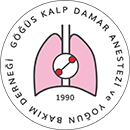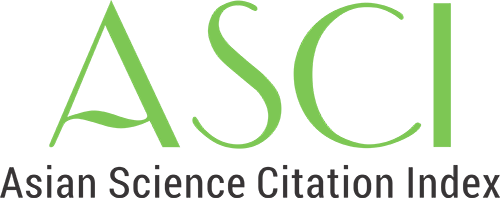

Volume: 24 Issue: 2 - 2018
| RESEARCH ARTICLE | |
| 1. | Analysis of the imflammatory effects of sevoflurane and izofluran on healty rat lung Fatma Acıl, Cem Kıvılcım Kaçar, Osman Uzundere, Sedat Kaya, Abdulkadir Yektaş doi: 10.5222/GKDAD.2018.20092 Pages 45 - 59 (2846 accesses) INTRODUCTION: We aimed to investigate the effects of isoflurane and sevoflurane on lung inflammation and alveolar epithelial apoptosis in rat model. METHODS: Twenty-one rats were randomly allocated into three groups. The subjects were mechanically ventilated for 2 hours in Control group (n=7) with 50 % oxygen + 50 % air mixture; in Isoflurane group (n=7) with % 1.2 isoflurane + 50 % oxygen + 50 % air and in Sevoflurane Group (n=7) with %2.4 sevoflurane + 50 % oxygen + 50 % air mixture. The MPO activities of the groups, TBARS levels, alveolar macrophage counts and alveolar epithelial apoptotic cell counts were.evaluated statistically. RESULTS: MPO activity in Sevoflurane group compared to isoflurane and control groups were significantly low. Furthermore, TBARS levels in Sevoflurane group compared to the other groups were also significantly low. MPO activity in Isoflurane group were significantly high compared to control group. Alveolar macrophage counts and M-30 positive cell counts in Isoflurane group were significantly high compared to sevoflurane and control groups. On the other hand, the alveolar macrophage counts and M-30 positive cell counts in sevoflurane group were significantly high compared to control group. Light microscopic findings observed in sevoflurane group and any more in isoflurane group were; diffuse mononuclear cell infiltration, diffuse alveolar injury, alveolary oedema, thickening of alveolar septums, dense alveolar macrophage and light neutrophil and type II pneumocytes infiltration in alveol lumen. DISCUSSION AND CONCLUSION: According to the results of this study, sevoflurane was found to cause less alveolar injury in healthy lung than isoflurane. |
| 2. | The Effect of Waist Circumference/Chest Circumference Ratio on Mortality in Intensive Care Units Işıl Coşkun Musaoğlu, Murat Aksun, Atilla Şencan, Kaan Katırcıoğlu, Nagihan Karahan doi: 10.5222/GKDAD.2018.30085 Pages 60 - 66 (1819 accesses) INTRODUCTION: Abdominal obesity causes many health problems such as cardiovascular diseases and metabolic disorders. BMI does not give us information about body fat distribution. Waist circumference measurement demonstrates abdominal obesity more clearly. Therefore, we believe that it will be more accurate to use waist circumference in intensive care scoring systems in predicting mortality. METHODS: In this study we investigated the patients ages, BMIs, waist circumference, chest circumference, waist circumference/chest circumference, APACHE 2 scores, SOFA scores, duration of mechanical ventilation and length of stay in ICU. We searched the effects of waist circumference/chest circumference ratio on mortality, whether this ratio is more sensitive than body mass index by itself in determining mortality and its relationship between length of stay in ICU and duration of mechanical ventilation. RESULTS: We found no statistically significant difference between waist circumference, chest circumference and mortality. Similarly, there was not a significant difference between BMI and mortality. DISCUSSION AND CONCLUSION: We think that we need large, multi-centered studies to find the exact relationship between waist circumference and mortality in ICU. |
| 3. | Our Experience with Anestetic Management of Pulmonary Thromboendarterectomies Tülay Örki, Halide Oğuş, Atakan Erkılınç, Rezzan Yaltırık, Deniz Avan, Canan Güler, Füsun Güzelmeriç, Tuncer Koçak doi: 10.5222/GKDAD.2018.37880 Pages 67 - 73 (1306 accesses) INTRODUCTION: We aimed to present anesthetic management and clinical results in 235 patients who underwent pulmonary thromboendarterectomy (PTE) surgeries between February 2008 and December 2014. METHODS: A thermodulation catheter was inserted for complete monitorization (cerebral regional oxygen saturation, rSO2) ECG peripheral tissue oxygen saturation (SpO2), invasive arterial and central venous pressure, cardiac output (CO), cardiac index (CI) pulmonary vascular resistance (PVR) measurements in the operation theater. Pulmonary thromboendarterectomy (PTE) was performed accompanied by cardiopulmonary bypass and deep hypothermic total circulatory arrest. The mean arterial pressure, (mAP), CO, CI, PVR, and the mean pulmonary artery pressure (mPAP) pulmonary artery pressure (mPAP) v were recorded by measuring after pump following anesthesia induction. The length of ICU and hospital stay, neurological symptoms, total mortality, and mortality during ECMO were recorded. RESULTS: Significant decrease in mPAP and PVR values and a significant increase in CI and CO values were detected after pump according to the measurements after induction. (p<005). The ICU stay was 6.7 + - 4.6 days and a hospital stay 12.5 = + - 6.8 days. Total mortality was 11.9%, ECMO was 12.8% and mortality associated with ECMO was 6.4%. No permanent neurological deficit developed in any patient. DISCUSSION AND CONCLUSION: In conclusion, PTE is a complicated cardiothoracic surgery. With competent anesthesia management, the risk of complications is reduced and the quality of life is increased. |
| 4. | Relationship Between Lactate Levels And Complications In Coronary Artery Bypass Grafting Surgery Selim Gülşan, Cengiz Şahutoğlu, Seden Kocabaş, Fatma Zekiye Aşkar doi: 10.5222/GKDAD.2018.93064 Pages 74 - 81 (2196 accesses) INTRODUCTION: In this study, we aimed to determine the relationship between lactate levels and complications in adult patients undergoing elective coronary artery bypass grafting surgery and the factors that cause high lactate. METHODS: Preoperative, intraoperative and postoperative data of patients were retrospectively scanned from their file information. In addition to this, parameters of lactate, glucose and other arterial blood gases were evaluated in patients with basal, cardiopulmonary bypass cooling, cardiopulmonary warming, sternal closure, postoperative zeroth hour, postoperative sixth hour, postoperative twelfth hour, and postoperative twenty-fourth hour arterial blood gases. Lactate values measured at any time in patients between 0-3.9 mmol / L lactate (Group 1, n=125 patients); and 4≥mmol / L lactate (Group 2, n=55 patients). It was investigated whether there was a significant relationship between complications and either group. RESULTS: The mean age of the 180 patients taken to work was 61.7 + 9.6 years and 80% were male. The 3.3% of the patients had single coronary, 20.6% had two coronaries, 40.1% had three coronaries, 26.1% had four coronaries and 3.9% had five coronary anastomoses. Group 1 was significantly lower than the group 2s lactate values at the sternal closure, zeroth hour, sixth hour, twelveth hour, twenty fourth hour (p<0.001). There were no differences in complications and mortality except multiorgan failure (MOF, p=0.027) among the groups. DISCUSSION AND CONCLUSION: Lactate in patients undergoing coronary artery surgery may increase intraoperatively and postoperatively and reach the highest value at 12 hours postoperatively. However, excluded in MOF, there was no significant relationship between high lactate levels and complications. |
| CASE REPORT | |
| 5. | A giant pericardial cyst as a rare cause of shortness of breath Umut Kocabaş, Atilla Pekçolaklar doi: 10.5222/GKDAD.2018.80707 Pages 82 - 84 (1011 accesses) Pericardial cysts are uncommon benign congenital cardiac anomalies and they are usually asymptomatic. This case demonstrates the importance of pericardial cysts and its rare complications such as cardiac compression and shortness of breath. |
| LETTER TO THE EDITOR | |
| 6. | Our therapeutic approach to pregnant patient with superior vena cava syndrom Abdulkadir Yektaş, Süleyman Sabaz, Sinan Aşar, Gülay Eren Aşık, Oya Hergünsel doi: 10.5222/GKDAD.2018.32559 Pages 85 - 91 (1092 accesses) Abstract | |
| CASE REPORT | |
| 7. | Foreign body aspiration in patients with tracheostomy after laryngectomy Emel Gündüz, Hanife Karakaya Kabukçu, Tülin Aydoğdu Titiz doi: 10.5222/GKDAD.2018.60565 Pages 92 - 95 (2184 accesses) Foreign body aspirations are rare in adults compared with children and sometimes could be fatal. The most common symptom is severe coughing which appears after choking. Symptoms include shortness of breath, fever, hemoptysis, chronic cough and recurrent pneumonia. Foreign body stays too long when atelectasis, chronic pulmonary infections, abscess, bronchiectasis may develop complications such as. Removal of the foreign body in a fast and secure method is very important in terms of protection from serious complications. Bronchoscopy is recommended for diagnosis and treatment. 76-year-old male patient 22 years laryngectomy with tracheostomy cannula tracheostomy home cleaning brush has aspirated. Made rigid and flexible bronchoscope is connected to a tracheostomy granulation tissue formed by ejecting a brush can not be removed right thoracotomy patients is presented. |

















